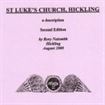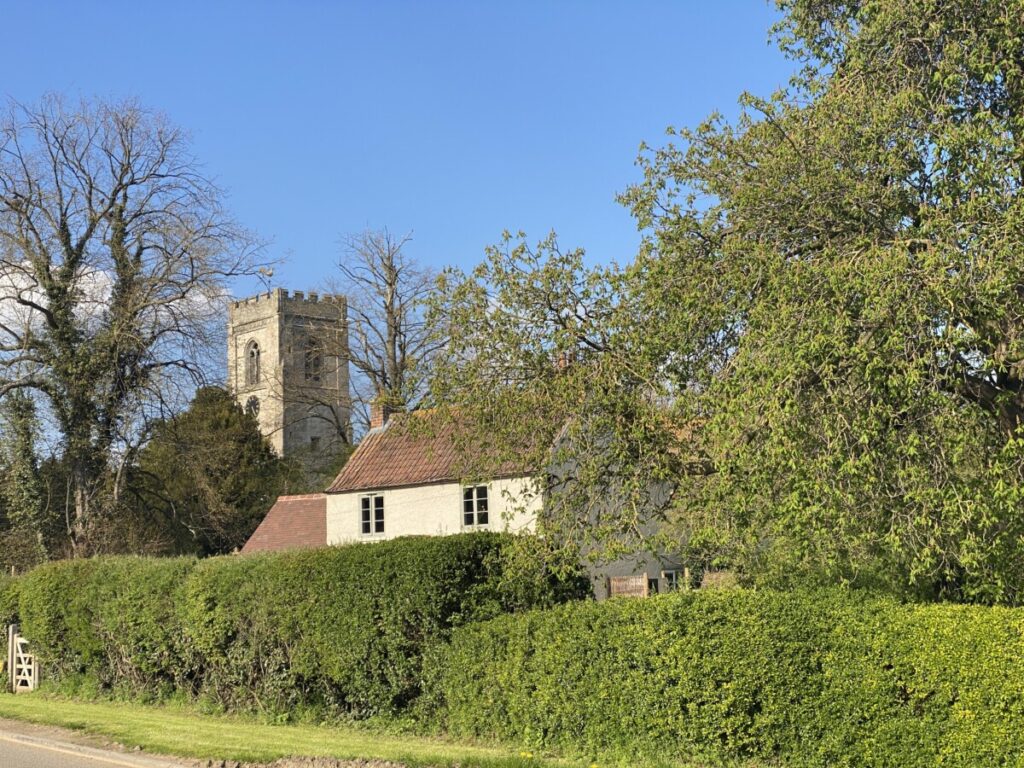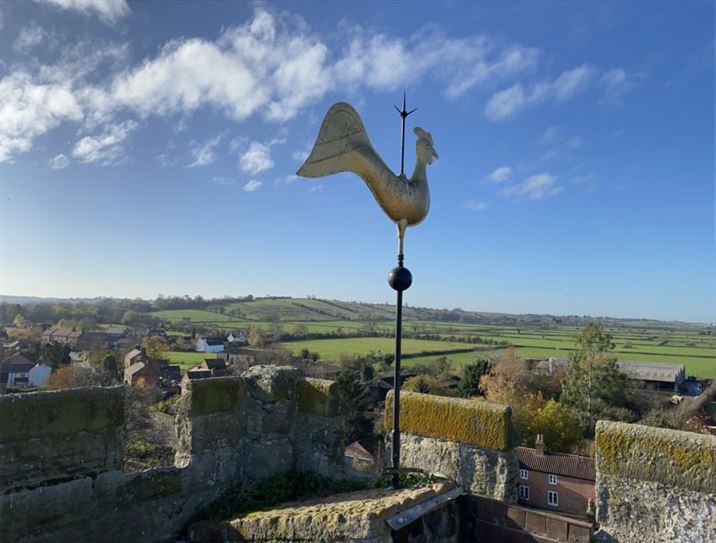We haven’t reached this page yet; please contact us if you are interested in this page and would like more information or if you have anything that might help us.
St. Luke’s Church, Hickling:
A Description (by Rory Naismith, 2000)
St Luke’s Church, Hickling.
(by Carol Beadle)
The following information has been drawn from an original guide compiled by Revd L W Foster, former Rector in 1947. This has been added to and brought up to date.
- There has been a Church here for over 900 years though the present building dates mostly from the first half of the 14th century. It was originally dedicated to St Wilfred.
- The ‘List of Reqtors’ in the porch shows the names of priests since 12Z7 AD
- The SOUTH DOOR is 13th Century, with very fine foliated wrought iron hinges. Notice the graffiti from the 1700s!
- The POOR BOX on the end of the pew immediately opposite the door is dated 1685, the lid is not original as unfortunately it has been broken open in the past. Recently restored as a donation safe.
- On the left is the FONT originally circa 1400 but re-carved in Victorian days (1800s). Under the bowl are the original half angels. The font cover is dated 1665 and is a pleasant example of village craftsmanship.
- In 1999 the South Aisle Vestry was extended and converted and now houses a toilet and a small kitchenette.
- The table by the south door is made up of elaborately carved wood said to be parts of the old screens, possibly Jacobean.
- The SOUTH AISLE. At one time this was divided off from the body of the Church by screens and used as a chapel. Note the PISCINA on the right and a square opening in the pillar on the Ieft, said to be an AUMBREY.
- The CHANCEL is unusually long, much restoration was carried out in the 1840s. Note the two fine brass candelabra, also the two benches dating from the 15th century with the comical heads carved on them. The East window contains many fragments of medieval glass including the arms of Henry VII. The Victorian Reredos contains a picture of the supper at Emmaus (Luke Ch 24:13-35). The two chairs in the chancel have carved on their arms the heads of Victoria Queen and Prince Albert.
- The Mothers’ Union banner was given in memory of T C Starbuck killed in the second World War in Italy.
- Halfway down the Chancel is a memorial brass to Ralph Babyington, Rector of Hickling 1515 – 1521 AD (Restored 1997) It is unusual in showing the priest fully robed for Mass and holding the Chalice.
- The ‘SAXON COFFIN LID’ on the north side of the Chancel was restored and moved from an upright position in the South Aisle in 1999 due to deterioration. It is a pre-Nornan sculptured coped tomb-cover, mid-10th Century. Described by Rev G F Browne Professor of Archaeology at Cambridge in 1888 as ‘the most perfect an invaluable pre-Norman work of its kind in England’. The bar of the cross passes out of the snout of a bear at each end reminiscent of the Scandinavian custom of casting a bear skin over the corpse of a warrior.
- On the other side of the Chancel the VAUX tombstone has been placed following removal from the Churchyard. It was discovered in 1983 and moved into the Church in 1999. This dates from the early 17th Century. The inscription reads ‘Here lies William Harrowden on whose soul may God have mercy, Amen’
- The NORTH AISLE was probably once a chapel to the Virgin Mary. The slab of stone sticking out on the right hand side may have been a bracket for a figure of the Virgln.
- When the Methodist Chapel in the village was closed and sold the War Memorial Board was removed and placed in the Church.
- The PARISH CHEST’ originally had three locks, the keys were held by the Rector and Churchwardens, so that there were always three people present when it was opened.
- The organ made by Brycesson in the 1840s was restored in 1986.
- The TOWER was rebuilt in 1873 using the original stone. In 1984 the ringing chamber floor
- was installed and in 1986 the original five bells made up to six. In 1996 a new steel bell frame was installed with a seventh bell. The eighth was added in December 1998. The Tenor bell weighing 10 cwt and made in 1618 bears the inscription, “All men that heare my mournfull sound repent before ye lye in ground.”
- The tower was re-roofed in 2003 when the pinnacles were removed for safety purposes.
- In the Tower Vestry are hung two Armorial Boards; one bearing Royal arms of George II, the other the Arms of Queens’ College, Cambridge, the Patron of the Living. Restored in 1996.
- Over the door to the tower are the arms of Nicholas Penny, Rector 1720 – 1730 when he became Dean of Lichfield Cathedral.
- The Church stands as a ‘mission in mortar’ to remind us of the love of God in Christ Jesus’ It is set apart as a place of worship; a place of pilgrimage; and a place of promise. It is a place to remind us of our own Christian roots.
- Before you leave sit awhile.
- Recall the goodness of God to you.
- Offer to God whatever is on your mind.
- You may like to use this prayer of St Richard of Chichester (1 197 – 1253): Thanks be to thee, O Lord Jesus Christ, for all the benefits which thou hast given us; for all the pain and insults which thou hast borne for us. O most merciful redeemer, friend and brother, may we know thee more clearly, love thee more dearly, and follow thee more nearly; for thine own sake. Amen
OUTSIDE
- Note the marks on the East side of the Tower, showing that the roof was originally much steeper. It was lowered because the thrust was tending to push out the walls.
- On the west end of the South Aisle is a fine example of a floriated stone tomb cover.
- There are many unusual slate headstones from the 18th century. Notice the group opposite the South Door with the round-faced winged angels. Some of the inscriptions are raised rather than incised. The angel motif has been included in the Village Sign which stands at the junction of Main Street and Bridegate Lane; unveiled in February 2000.
- On one window jamb are the remains of a scratch dial, by which the priest told the time for services before clocks were common.
How the Church got here.
(by C Beadle)
The OId Religion
Religion in these three parishes con be traced back to the lron Age, as somewhere between Upper Broughton and Willoughby lay ‘the great sacred grove’, deduced from the Roman placename Vernemetum, which was a small fortress and town sited on the Fosse Way. There was a tumulus (now almost ploughed out) for a high-status Iron Age burial, and then a substantial Roman cemetery and finally a pagan Anglo-Saxon cemetery. Clearly, this windswept site on the top of the Wolds was of some lasting religious significance.
A base for evangelism
It seems likely that the first fixed Christion site in the benefice was that of Hickling church, which may have been a minster church from which Priests went out to evangelise the surrounding area. It may even pre-date the formation of the present village. It is known that the area around the church was held by the canons of St Mary of Southwell, and with such influential patronage eventually today’s large and beautiful church was built. The Anglo-Saxon coffin lid in Hickling church (which may have been from the tomb of a major benefactor based on what is known of similar cases elsewhere) confirms the early importance of this site.
A pagan site re-used
ln the Domesdav Book the present day parish of Kinoulton seems to represent the area around the old Church on top of the hill. The area at the bottom, probably extending across the river to Colston Bassett, was the parish of Newbold, which was a royal manor held by Mercian nobility. This is the only place in the benefice where Domesdav mentions there being a church and a Priest, though by implication there was some form of church in all the other villages (see below). Recent work on the old church of Colston Bassett has shown a small area of Anglo-Saxon carving incorporated in the later building. This Church also appears to stand on a pre-Christian ritual site and beside a very early road – was this the Newbold Church mentioned in Domesday? The Venerable Bede reports thot Pope Gregory instructed St Augustine to sprinkle pagan sites with holy water and claim them for Christ – is that what we have here?
Churches on a boundary
Broughton Sulney was dedicated to St Oswald, who was a Northumbrian king who was martyred. Kinoulton old-Church was St Wilfred, who was a Northumbrian bishop. If these churches had been founded after the Norman conquest it is highly unlikely that they would have been dedicated to Northumbrian saints (e.g. Long Clawson church is dedicated to St Remegius, who was a French saint). It is also significant that the benefice lies on the border of the province of York, guardians of the Northumbrian heritage, and it is likely that dedication to ‘our saints’ on the border made a territorial statement.
Why here?
There is circumstantial evidence that the United Benefice of Hickling with Kinoulton and Broughton Sulney occupies what was part of a Roman estate, the other part being the parishes of Nether Broughton and Old Dalby. The two Broughtons were owned by Mercian royalty as was Newbold. Nether Broughton church contains Anglo-Saxon carving from an earlier building. Old Dalby, formerly Dalby on the Wolds, was the site of a Crusader base in the I2th and 13th centuries. It was the last-formed of the settlements, which gradually assimilated areas of Wold throughout the middle ages, finally taking in the last bit of extra-parochial of Six Hills in 1894. Six Hills also used its status as extra-parochial and on a County boundary to be a venue for prize-fighting and other unlawful activities. There was a similar tract of extra-parochial Wolds land, also assimilated in 1894 in the corner of Kinoulton parish at Lodge on the Wolds. Because there were no registers for Lodge on the Wolds, being extra-parochial, spinsters, who to their shame found themselves pregnant, went there to give birth. Similarly, the Wolds area of Hickling Pastures was ‘waste’ at Domesday and still 800 acres of waste at Parliamentary Enclosure of 1760, but being within a parish escaped being used for nefarious activities. All the present-day villages probably founded at nucleation in the 9th century, are sited on spring lines below the edge of the Wolds where the land is easier to work and less prone to waterlogging. The old church of Kinoulton was right on the edge of the Wolds, just on the heavy clay, which might account for why the village moved.



